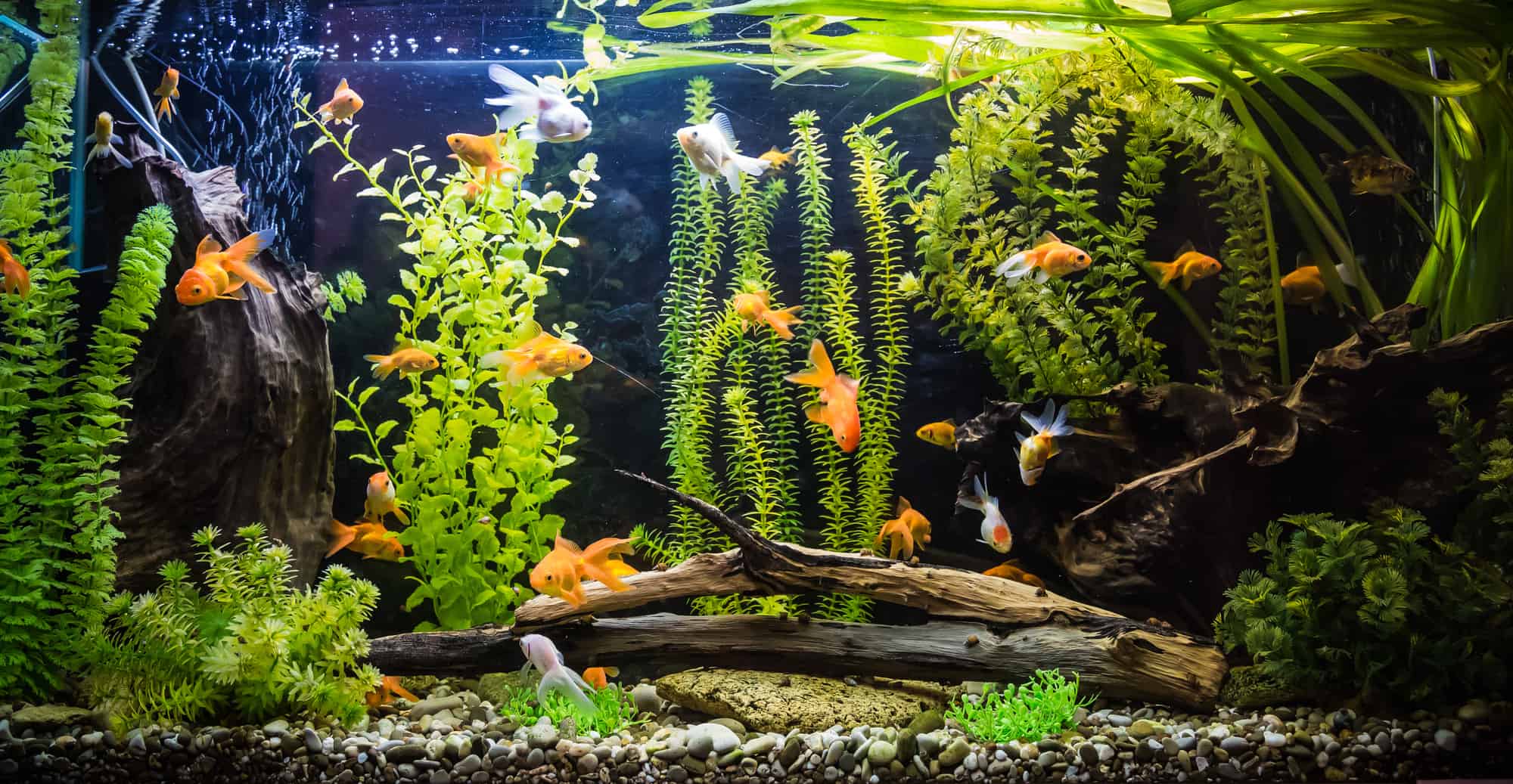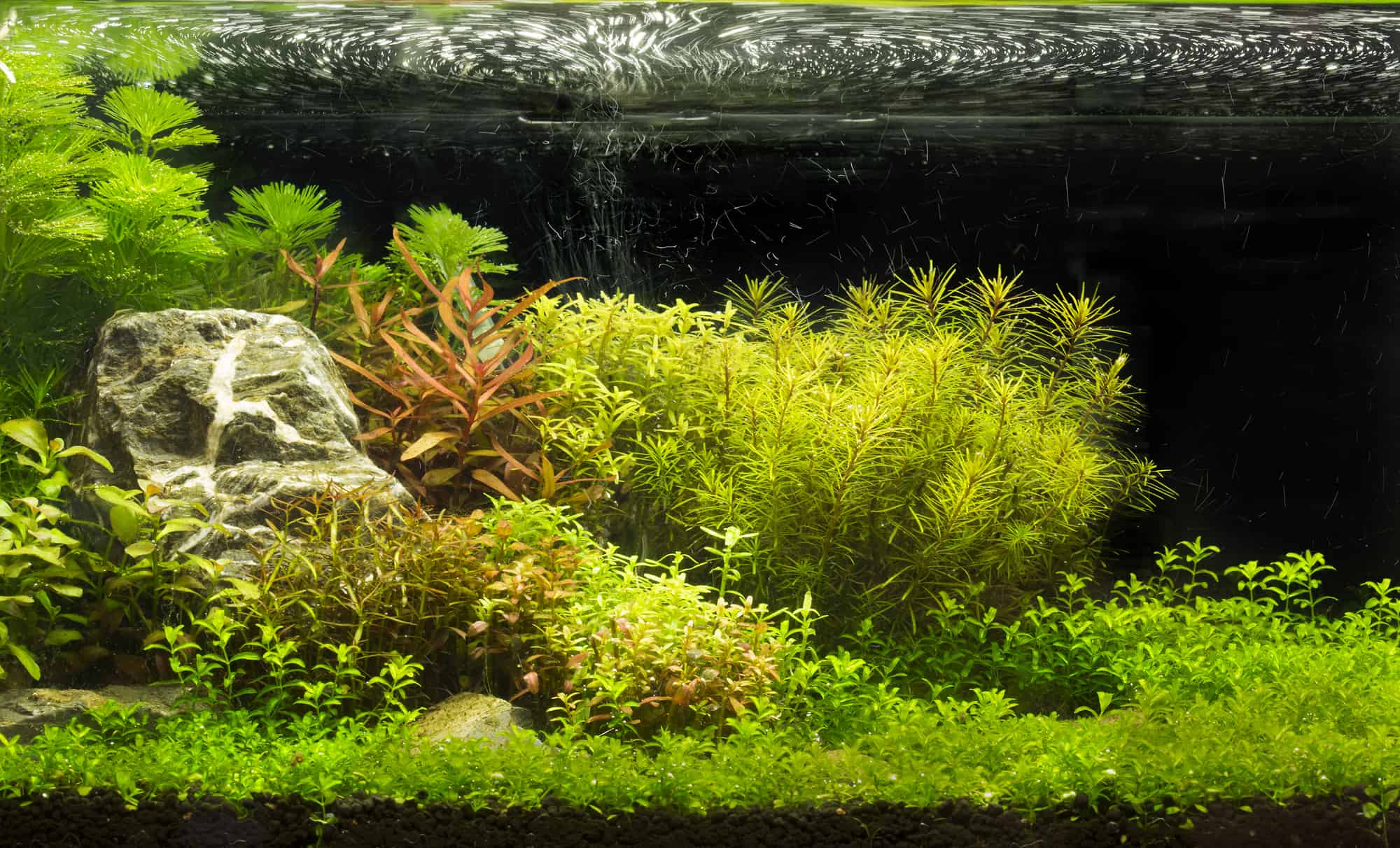These days, fake plants have become extremely popular as aquarium decoration pieces, largely because of their low maintenance and aesthetic appeal. Indeed, when I got into the fishkeeping hobby over 40 years ago, I had lots of silk plants adorning my first aquarium.
However, there are quite a few hidden downsides to using artificial plants in natural aquariums, particularly concerning the environment, the tank’s ecosystem, and your aquatic pets’ well-being.
In this guide, I expose the problems with using artificial plants versus living ones. Keep reading to find out why using faux foliage in your display tank might not be such a great idea after all!
Key Takeaways
- Fake plants in aquariums fall short of enhancing the tank ecosystem, as they do not oxygenate water, absorb excess nutrients, or support beneficial bacteria like live aquatic plants do.
- The environmental impact of fake plants is considerable, involving non-renewable resources and potential water contamination, whereas live plants can be home-grown and biodegrade naturally.
- Though artificial plants necessitate less upkeep, real plants can propagate, reduce the need for chemical water treatments, and offer a more authentic and stimulating environment for fish.
Summary Table
Take a look at this summary table to get an at-a-glance comparison between real and fake plants.
What would you go for on first impressions, fake foliage, or the real deal?
| Feature | Fake Plants | Real Plants |
|---|---|---|
| Contribution to Ecosystem | Do not oxygenate water or absorb nutrients | Produce oxygen, absorb nutrients, prevent algae |
| Safety for Fish | Can have sharp edges, may release toxins | Safe, no sharp edges, no toxins |
| Maintenance | Low maintenance, require cleaning and replacement | Need pruning and can propagate naturally |
| Cost | Can be expensive, not regenerative | Can propagate, long-term cost-effective |
| Environmental Impact | Made from non-renewable plastics, can leach dyes | Biodegradable, can be grown locally |
| Aesthetic Longevity | Colors fade, can look shabby over time | Stays vibrant, enhances natural beauty of tank |
| Stimulation for Fish | Limited natural behavior encouragement | Encourages natural behavior, provides habitats |
| Support for Beneficial Bacteria | Non-porous, not ideal for bacteria colonization | Provide surfaces for beneficial bacteria |
| Nutrition for Fish | Inedible | Some species are a food source for fish |
Choose wisely between fake and real plants for your aquarium, as they significantly differ in their contributions to the aquatic environment, fish behavior and safety, and overall sustainability.
Fake Plants Don’t Contribute to the Ecosystem

Artificial plants do not contribute to the ecosystem in the same way natural plants do; all they do is look good.
In contrast, living aquatic plants play a crucial role in your fish tank, oxygenating the water through photosynthesis, a process by which they utilize light energy to convert carbon dioxide and water into oxygen and glucose.
During photosynthesis, plants release oxygen into the surrounding water, which benefits aerobic organisms like fish and invertebrates by replenishing crucial dissolved oxygen levels. That prevents oxygen depletion, helping to support aerobic respiration in aquatic organisms.
Fake plants can’t act as nutrient sinks. Natural plants use excess nutrients like nitrates and phosphates as a food source, helping to prevent algae blooms and maintain the water quality in your aquarium.
Living Plants Control Algae and Clean the Aquarium Water
Unlike fake plants, natural plants absorb nutrients from the water column and substrate, including nitrogen compounds like ammonia, nitrite, nitrate, phosphorus, and micronutrients like iron and potassium. By absorbing excess nutrients, natural plants compete with algae for resources, reducing the availability of nutrients that promote algae overgrowth.
This nutrient competition helps prevent algae blooms and maintains a balanced ecosystem, keeping the water crystal clear and reducing the need for the use of chemical algae controls.
Live Aquatic Plants Stabilize the Water Chemistry

Natural plants play a critical role in stabilizing water chemistry by influencing pH levels and carbonate hardness (KH) through their metabolic processes.
As mentioned earlier, plants consume carbon dioxide during photosynthesis, which can help lower pH levels in aquariums with elevated CO2 concentrations. In addition, plants taking up carbonate ions during photosynthesis can gradually reduce carbonate hardness, promoting stable pH levels and buffering capacity over time.
Living plants encourage natural fish behaviors
Although fake plants can provide places for fish and invertebrates to explore and hide, they don’t offer the same degree of complexity and texture as real plants. As a consequence, your fish can’t behave naturally, grazing, foraging, and spawning in an environment devoid of natural plant life.
In comparison, natural aquatic plants provide lots of textures, shapes, and hiding places that encourage natural behavior in your aquatic pets. They provide refuge for shy or territorial fish, spawning sites for breeding species, and grazing areas for herbivorous fish and omnivores.
That helps to reduce stress and promote overall well-being by mimicking your pets’ natural habitat.
Fish Safety
When it comes to your fish’s welfare, living plants are a much better choice. Live aquatic plants don’t have sharp points or rough edges and won’t leach toxic chemicals into the water.
Silk plants are usually safe, although the cheaper ones can sometimes contain harmful chemicals that get into the water and could poison your fish. If you choose silk plants, always opt for the best quality you can find.
I don’t recommend using plastic plants in a fish tank, especially if you keep fish with trailing fins and tails. Many plastic plants have sharp edges that could easily snag vulnerable fins, cause a nasty injury to your fish, and are best avoided.
Cost
Fake plants are quite expensive. A decent-quality faux plant will often set you back just as much as a real one, depending on the plant’s size, color, and quality. Of course, if you buy a good-quality artificial plant, it will last you for a long time, whereas living plants often die off unless you provide them with perfect growing conditions.
Aesthetics

If you have a particular color scheme or theme in mind for your fish tank, silk plants can be a great choice. In addition, you can keep replicas of unusual or hard-to-keep plants that are challenging to keep healthy in the real world.
However, fake plants tend to fade and lose their vibrant colors over time, leaving you with shabby specimens that must eventually be thrown out and replaced.
In contrast, living plants can add a beautiful, vibrant green backdrop to your tank that highlights the beauty of your fish. Plants come in many different shades, from bright lime greens to darker, more sobre tones. You can also buy red and pink plants, although those species tend to need brighter lighting conditions that might not suit your fish.
Cleaning Faux Plants Is Not as Easy as You Might Think
If you keep algae-eating fish and invertebrate species, your pets will nibble on algae growing on fake plant leaves and tank surfaces. However, artificial plants tend to collect general detritus, quickly becoming dirty eyesores. Of course, you can clean fake aquatic plants by scrubbing them, but that’s a hassle, and old faux plants are easily damaged, leaving them frayed and tatty.
Living plants get dirty, too. However, you can sponge away algae or trim off damaged leaves. After all, live plants will quickly grow new leaves to replace any you’ve removed.
Fake Plants Need Little Maintenance

Aside from cleaning and replacing your artificial plants when necessary, they don’t need any maintenance. On the other hand, live plants need frequent pruning, trimming, and thinning out to keep them in good condition.
That said, your living plants will repay your diligence by producing plenty of plantlets through natural propagation. Some species even bloom, too!
You Can’t Propagate Fake Plants!
One major downside to keeping fake plants is that you can’t propagate them as you can living ones. If you have to throw out any of your old artificial foliage, you’ll need to buy more, and that can get very expensive over time.
Living plants are much easier to propagate. Some species reproduce by putting out trailing rhizomes under the substrate. Baby plants grow from the rhizomes, quickly spreading around your aquarium floor.
Other varieties simply grow plantlets from their stems. All you need to do is carefully snip off the baby plants and replant them in your tank. Many times, I’ve had so many baby plants I’ve ended up giving them away to friends. That’s much cheaper than buying more!
Fish Can’t Eat Fake Plants

Many omnivorous fish species like to nibble on living plants as a regular part of their diet. Although that can be a pain if they uproot your plants in the process, plant matter forms an important part of their nutrition.
Of course, your fish can’t eat fake plants. That means you’ll need to provide your fish with veggies or herbivore foods instead, incurring more fishkeeping costs.
Living Plants Provide a Home for Beneficial Bacteria
Natural plants provide physical surfaces and structures that serve as habitats for beneficial bacteria, including the all-important nitrifying bacteria involved in the nitrogen cycle. These bacteria colonize the surfaces of plant leaves, stems, and roots, where they help to lighten the load on your biological filtration system by breaking down organic waste compounds, such as ammonia and nitrite, into less toxic nitrates.
Artificial plants don’t offer a suitable home for beneficial bacteria, largely because their surfaces are non-porous or very smooth.
Producing Fake Plants Can Damage the Environment

Most fake plants are made from synthetic materials such as plastics, including polyethylene, polypropylene, or PVC (polyvinyl chloride). Producing plastics demands extracting and processing fossil fuels, primarily natural gas and crude oil, which are non-renewable resources.
As most people are aware, the extraction and processing of these fossil fuels contributes massively to degradation, including habitat destruction, air and water pollution, and greenhouse gas emissions.
In addition, many artificial plants are made overseas, meaning they’re transported by air, sea, or overland, further contributing to global warming. In contrast, commercial producers can grow living plants in your home country, minimizing the need for excessive transport and minimizing carbon footprint.
Fake Plants Contain Dyes and Pigments

Most fake plants are artificially colored to mimic the appearance of natural vegetation. Unfortunately, the dyes and pigments used in manufacturing sometimes contain hazardous chemicals and heavy metals, such as lead, cadmium, and chromium, which can leach into the environment during production or disposal and contaminate the aquarium water.
In contrast, dead plants simply degrade and decompose, being absorbed back into the environment naturally and providing a source of food for microbes, bacteria, and small organisms. That said, you must remove dead plant matter from your aquarium to prevent the water from becoming polluted.
Final Thoughts
Although fake plants can look great in your aquarium, they do have hidden downsides.
Unlike artificial plants, real ones help to keep your aquarium water parameters stable and healthy and support your filtration system by providing a home for beneficial bacteria. Fake plants can fade and get dirty over time, whereas real ones stay beautiful throughout their lives, provided you trim them periodically.
Fake plants are expensive to buy and won’t regenerate, whereas real ones can be propagated, rewarding you with dozens of plantlets.
Of course, you and your aquatic pets can enjoy the best of both worlds if you use a combination of high-quality silk plants and locally grown living ones.


